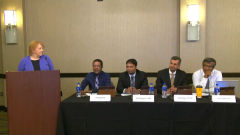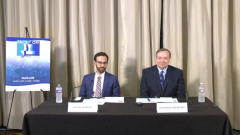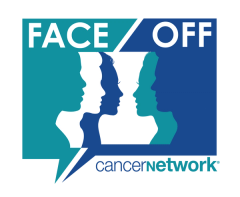
Chronic Myeloid Leukemia: Long-Term Follow-up of Low-Dose Dasatinib
In the last presentation of the session, Abhishek Mangaonkar, MBBS, details clinical trial data with low-dose dasatinib in patients with chronic myeloid leukemia.
Episodes in this series

Transcript:
Judy Schreiber, PhD, RN: Thank you very much. Now for the last presentation, we’re going to [look] at the low-dose dasatinib.
Abhishek Mangaonkar, MBBS: I’ll present this paper from [The University of Texas] MD Anderson [Cancer Center] group, which…compared low-dose dasatinib as a frontline therapy option in [patients with] newly diagnosed chronic-phase CML [chronic myeloid leukemia]. [First,]just a bit of background. The MD Anderson group, led by [Hagop M. Kantarjian, MD,] and other authors published this [paper on] low-dose dasatinib as a potential treatment strategy in chronic-phase CML. So the label dose that got approved initially, as per the DASISION study [NCT00481247] with dasatinib, had the dose of 100 mg in chronic-phase CML and then 140 mg in accelerated-phase and blast-phase patients. The authors here came up with a hypothesis that maybe low-dose dasatinib is just as effective as the standard dose, the 100 mg in [patients with] chronic-phase CML. They included 83 patients in the study, all in chronic phase. [It is] very important to note that a vast majority of these patients were in the low- and intermediate-risk category. This was assessed by the prognostic scoring system, Sokal risk groups.
Only 9%of these patients were in the high-risk category. Dasatinib has quite a bit of the TKI [tyrosine kinase inhibitor] adverse events but quite a bit of unique adverse events such as pleural effusions and pulmonary hypertension. Adverse events such as pleural effusions were much lower with this low-dose dasatinib at 50 mg, around 6%, and I’ll share the data from the original study with these adverse events. The median follow-up here was around 2years. At 3 months, about 96% of the patients achieved the BCR-ABL transcript less than 10%, and about 77% of the patients less than 1%.We used that as a prognostic marker, a disease response marker. That was pretty good with this low dose. The 12-month major molecular response rate was 81%. The cumulative incidences of these deep responses, the MR4, MR4.5 and complete molecular response, were 63%, 53%, and 46%, [respectively, which is] quite good.
Now, how does that compare to the other doses—so, the dasatinib 100-mg dose, 6-month response of complete cytogenetic response. Now, complete cytogenetic response is a very important end point because that is one of the well-validated end points that correlates with overall survival in CML. You can see that, surprisingly, the complete cytogenetic response rates were higher with the lower dose, 50 mg, compared [with] the 100 mg in the DASISION study. Again, this is like a cross-trial comparison that was published, but it’s still a valid comparison. Now, the cross-trial was just between imatinib and the others. In the study that was done originally at MD Anderson, they used both doses in patients. The imatinib especially was a historical control, so maybe that’s not a very accurate comparison, but still it was surprising to see that the 50-mg dasatinib dose had a higher response. I think the thinking for this was maybe [that] there were fewer treatment interruptions, there were fewer toxicities, and so patients were able to stay on that dose for a longer period…. How does the major molecular response compare? Again, if you look at 3, 6, 9, and 12 months, at all these time points, the major molecular response rates were higher with the 50-mg dasatinib dose compared [with]the 100-mg dose and better than historical imatinib controls as well. This is again a very good example of how we don’t have to always try the maximum tolerated dose.
We could go with a lower dose and maybe achieve the same responses in these patients. Again, in this paper, they published the overall survival and event-free survival. You can see this is an expected CML overall survival curve, which is at 36 months, pretty much everybody’s alive. But the failure-free survival was also quite impressive, around 93% at 24 months. Now, this abstract that was published at ASH [American Society of Hematology] last year, published the long-term,5-year follow-up of these patients. There was, again, hesitation in the field [about]why, long term, we may see more relapses with the lower dose. At [a] median follow-up of 5years, the 5-year failure-free survival, event-free survival, overall survival rates were still quite good…in the 88% [range]. The overall survival rate was, again, close to 100%. Treatment was again, obviously well tolerated at the lower dose of the dasatinib compared with the 50 [mg] vs 100 [mg], and the rates of pleural effusions were a lot lower, 5% to 3% range.
So really, I think emphasizing the low-risk and intermediate-risk patients especially, this is something that I would consider as practice changing, and I tend to start with a lower dose now in these patients.
Transcript edited for clarity.
Newsletter
Stay up to date on recent advances in the multidisciplinary approach to cancer.






















































































